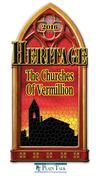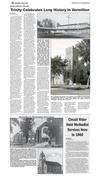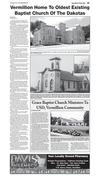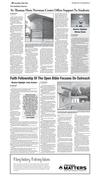3




Heritage 2016, www.plaintalk.net
Vermillion Plain Talk
3B
Vermillion Home To Oldest Existing
Baptist Church Of The Dakotas
BY DAVID LIAS
david.lias@plaintalk.net
Formally organized in December 1870,
the First Baptist Church in Vermillion is the
oldest existing Baptist Church in North and
South Dakota.
The church was originally located below
the bluff, at the foot of Ravine Road (Dakota
Street) across from the old log schoolhouse.
That church survived the flood that destroyed most of Vermillion in 1881.
On the night of March 27, 1881, the community was warned of the impending flood
by the tolling of the bell outside the church.
“The building was below the hill just
at the bottom of Dakota Hill.There’s this
big stone monument there where the first
church sat. The bell rang all night in 1881
when Vermillion flooded,” Pastor Sandy
Aakre said. “Everybody came to the sound
of the bells. No one died but the town was
destroyed except for the church and the old
schoolhouse and there’s a monument on the
east side going down Dakota Hill where the
old schoolhouse was so they’re right across
from each other.
“Then they moved the church up the hill,”
he said.
Mr. Hill, a housemover from Sioux City,
Iowa, moved the church up to the bluff on
the southeast corner of Main and Church
streets in September 1881.
“They had a team of oxen and two donkey, 18 or 16 span oxen. They rolled it up the
hill using log rollers,” Aakre said. “The oxen
pulled it up to where the West side of the
church is. In 1889 they build the east side of
the church.”
Just nine years after being moved up the
bluff, the old building was moved again to
18 Church Street to make room for a new
structure.
The cornerstone was laid on Oct. 10,1889,
and the new sanctuary was built of Sioux
quartzite and was dedicated in May of the
following year.
The Vermillion Baptist Church continued
to grow in numbers after the new building
was constructed.
The most recent addition to the church
was in 1925, when Lewis Hall was built
directly to the west of the existing church.
The original church building, which had
served as a gymnasium and meeting room
since 1890, was torn down to make room for
the extension. The new hall was also faced
with Sioux quartzite and has stood up well
over time.
The church building houses a priceless
musical instrument. In the spring of 1888,
a pipe organ was presented to the church
by Mr. E.A. Lewis, the mother of Martin J.
Lewis. Mr. Lewis was a member of the firm
of Thompson and Lewis, pioneer implement
dealers in Vermillion.
The tracker organ was constructed in
1888 by William Schuelke of Milwaukee,
Wisconsin. The instrument was dedicated on
May 3, 1888.
The Dakota Republican reported: “The
new pipe organ was in use for the first time
last Sunday with Professor F.A. Ballaseyus,
head of the department of music at the
University, at the organ. Mrs. D.M. Inman,
soloist, and the university choir assisted in
the dedication service.”
In 1890, the instrument was moved to the
present Lewis Hall. On Dec. 3 of that year,
the well-known musician, Clarence Eddy,
presented a recital at the re-dedication.
A newspaper account stated: The loft in
which the organ is placed renders its tone
much clearer, much more powerful and better in every way than was the case in the old
church … It is the costliest, largest, and best
organ in the state.”
William Schuelke Jr., son of the original
builder, moved the organ to the present
sanctuary in 1925.
It was decided in 1961 to have the Schuelke organ rebuilt, instead of replaced. This decision was made at the advice of USD Professor James Boeringer. He was also influential
in having the 1887 Marklove organ, Opus 146,
of the Episcopal church in Yankton, brought
to Vermillion in 1961 and incorporated in the
Trinity Lutheran Church’s organ. This means
Vermillion is the home of the first two organs
installed in Dakota Territory.
A. Eugene Doutt rebuilt the organ in
1961. Three changes were made in the stops
to make the instrument more versatile for
use in the church service. The organ was
lowered in pitch a quarter-step and softened
as much as possible.
During the church’s centennial celebration, Theo Rayburn Wee, who had been
organist during her student days, returned
and performed a concert.
The family of A.A. and Pansy Austin
Whittemore presented a gift of the “Whittemore Memorial Chimes” in 1969. The chimes
keyboard attachment sounds either inside or
outside the building.
In July 1982, Gary Stewart of the Shrine
to Music Museum (now the National Music
Museum) removed the original bellows and
completely restored them with new skin
coverings and hardware.
The Schuelke organ, housed in a historic
structure, is believe to be the oldest organ in
continuous use since Territorial days.
DAVID LIAS/FOR THE PLAIN TALK
The cornerstone of the First Baptist Church in Vermillion was laid in the fall of 1889, and the new sanctuary was dedicated in
May of the following year.
Originally located at the foot of Ravine Road (Dakota Street) across from the old log schoolhouse, the Baptist Church survived
the flood that destroyed most of Vermillion in 1881. On the night of March 27, 1881, the community was warned of the impending
flood by the tolling of the bell outside of the church. This image, provided by the SD State Archives, appears in “From the River
Valleys to the Rising Bluff – A Pictorial History of Vermillion, South Dakota.” Inset Photo Courtesy: Clay County Historical Society
Ruth M. Moses collection.
Grace Baptist Church Ministers To
USD, Vermillion Community
BY PASTOR STEVE FORD
Grace Baptist Church began as an outreach ministry to USD students in June of
1978. The group formally constituted as a
church in December of 1980. The church’s
property at 1102 E. Main St., across the
street from Vermillion High School, was
purchased in 1987 and the initial building
was built, all by volunteers, in the summer
of 1988. The current, expanded facility was
completed in August of 2004, all by volunteers as well.
Grace Baptist Church has had three senior pastors in its history: John Christy and
wife, Babs (1978-1982); Wayne James and
wife, Billie (1982-2005); and Steve Ford and
wife, Pam (2006-present).
Having started as an outreach ministry
to USD students, Grace Baptist Church has
remained committed to ministering to the
USD community. Students, faculty, and administrators from USD have consistently been a
vital part of the Grace Baptist body and we
have taken seriously a mission to welcome
students, help them grow in Christ while
they are in their college years, and encourage and equip them to become church and
community leaders after they graduate. Just
this month, the church has strengthened that
commitment by calling Brandon Pedersen to
be Pastor of Collegiate Ministry.
Grace Baptist is also committed to our
Vermillion community. We have enjoyed finding a place alongside other churches in town
to bless and serve our Vermillion neighbors.
We partner with the other churches of the
Vermillion Ministerial Association (VMA) to
help families in crisis through the VMA Emer-
COURTESY PHOTO: GRACE BAPTIST CHURCH
Grace Baptist Church began as an outreach ministry to USD students in June of
1978. The group formally constituted as a church in December of 1980. Finalizing
its church in 1988, the current, expanded facility was completed in August of
2004, all by volunteers.
gency Fund. In addition, we have also been
happy to lead the Winter Warmth Coat drive
each fall for several years as well as a prayer
support ministry for teachers at Vermillion
High School each school year. This past year
we had the privilege of drawing the Vermillion
community together to honor our citizens
with special needs with their very own prom
night, called Night to Shine. Plans are already
underway for Night to Shine 2017.
Grace Baptist is also committed to sharing
the love and glory of Jesus outside of our
community. We have ongoing missions partnerships on the Pine Ridge reservation and in
the country of Uruguay, where we send teams
each year.
Your Locally Owned Pharmacy













 Previous Page
Previous Page






